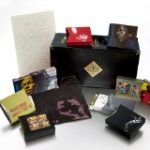
Columbia Records
So, dig this: a total of 43 CDs’ worth of Miles Davis, divided into eight individually-packaged box sets, and all packed into a full-sized trumpet case. Plus – we’re not done here yet – a replica of a Miles’ own mouthpiece, a never-before-seen lithograph by the man himself and an exclusive t-shirt (just in case you were on the fence about all this … the t-shirt will no doubt seal the deal).
The matter at hand is the newly-released The Genius of Miles Davis, which gathers up the eight individual box sets in The Miles Davis Series along with all those other neat goodies into one single collection that weighs in at a total of 21 pounds (just slightly heavier than the average sperm whale brain). And why am I telling you about all this, boys and girls? Because there is some truly amazing music here, that’s why.
The Genius of Miles Davis begins with our hero’s collaborations with John Coltrane for Columbia Records between 1955 and 1961 and takes us through to the supreme funk of the On The Corner Sessions (1972 to 1975). In between, we have Davis’ work with Gil Evans (_The Complete Columbia Studio Recordings 1957-1968_); the amazing sessions for Seven Steps; the recordings that Davis’ “second great quartet” (which included Wayne Shorter, Herbie Hancock, Ron Carter, and Tony Williams) laid down between 1965 and 1968; and from-the-vault offerings of the sounds that became In A Silent Way, Bitches Brew, and Jack Johnson. More than just something for the anal completist, this collection contains some serious jams, offering up an opportunity to see how the original albums developed – and in the case of Bitches Brew, for instance, a chance to see where it went from there in a live setting.
It was Davis himself who said, “I can’t do anything like anyone else – I’m just myself,” and the proof of that is what The Genius of Miles Davis is all about. It was a long, long road for the man and his various band lineups in the 20 years represented here, but the route is a fascinating one – from deep ventures into thick modal textures to total you-can’t-help-but-shake-your-ass rhythms … and throughout it all, Davis was just being himself, playing what he felt at that moment.
Along the way, we’re treated to a mind-numbing list of bandmates – many of whom took their first real excursions out there alongside of Miles Davis. Any attempt at naming them all would be too much for one sitting, but as an appetizer, consider that (along with the jazz legends already mentioned) folks such as Cannonball Adderly, Bill Evans, Jimmy Cobb, Joe Zawinal, Chick Corea, John McLaughlin, Billy Cobham, and Jack DeJohnette spun in and out of Davis’ musical orbit during the 20 years captured on these recordings. And during that time, Davis himself explored the boundaries of his trumpet’s sound employing everything from the standard mute to the then-exotic wah pedal as the muse demanded.
Miles Davis was known to be a man of few words at times – but when he did speak, you were pretty clear about how he felt at that moment. The mind boggles at what Mr. Davis might have to say about this cornucopia of jazz history.
“Man – is that the real shit, or what?” is one possibility.



No Comments comments associated with this post